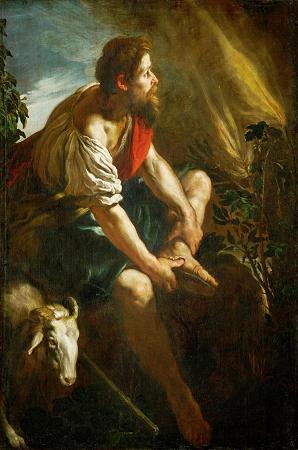Burning Bush. The burning bush is an object described by the Book of Exodus as being located on Mount Horeb. According to the narrative, the bush was on fire, but was not consumed by the flames, hence the name. In the biblical narrative, the burning bush is the location at which Moses was appointed by Yahweh to lead the Israelites out of Egypt and into Canaan. The Hebrew word in the narrative that is translated into English as bush is seneh, which refers in particular to brambles; seneh is a biblical dis legomenon, only appearing in two places, both of which describe the burning bush. It is possible that the reference to a burning bush is based on a mistaken interpretation of Sinai, a mountain described in Exodus 19:18 as being on fire. Another possibility is that the use of seneh may be a deliberate pun on Sinai, a feature common in Hebrew texts. In the narrative, an angel of the Lord is described as appearing in a bush, and God is subsequently described as calling out from it to Moses, who had been grazing Jethro's flocks there. When Moses starts to approach, God tells Moses to take off his sandals first, due to the place being holy ground, and Moses hides his face. Some Old Testament scholars regard the account of the burning bush as being spliced together from the Yahwist and Elohist texts, with the Angel of Yahweh and the removal of sandals being part of the Yahwist version, and the Elohist's parallels to these being God and the turning away of Moses's face, respectively. When challenged on his identity, Yahweh replies that he is the God of the Patriarchs-Abraham, Isaac, and Jacob-and that he is Yahweh. The text derives Yahweh from the Hebrew word hayah in the phrase ehyeh ašer ehyeh, meaning he who is he, or I am that I am. The text portrays Yahweh as telling Moses that he is sending him to the Pharaoh in order to bring the Israelites out of Egypt, an action that Yahweh is described as having decided upon as a result of noticing that the Israelites were being oppressed by the Egyptians. Yahweh tells Moses to tell the elders of the Israelites that Yahweh would lead them into the land of the Canaanites, Hittites, Amorites, Hivites, and Jebusites, a region generally referred to as a whole by the term Canaan; this is described as being a land of milk and honey. According to the narrative Yahweh instructs Moses to confront the Egyptians and Israelites and briefs the prophet on what is to take place. Yahweh then performs various demonstrative miracles in order to bolster Moses's credibility. Among other things, his staff was transmuted into a snake, Moses's hand was temporarily made leprous, and water was transmuted into blood. In the text, Yahweh instructs Moses to take this staff in his hands, in order to perform miracles with it, as if it is a staff given to him, rather than his own; some textual scholars propose that this latter instruction is the Elohist's version of the more detailed earlier description, where Moses uses his own staff, which they attribute to the Yahwist. Despite the signs, Moses is described as being very reluctant to take on the role, arguing that he lacked eloquence, and that someone else should be sent instead; in the text, Yahweh reacts by angrily rebuking Moses for presuming to lecture the One who made the mouth on who was qualified to speak and not to speak. Yet Yahweh concedes and allows Aaron to be sent to assist Moses, since Aaron is eloquent and was already on his way to meet Moses. This is the first time in the Torah that Aaron is mentioned, and here he is described as being Moses's mouthpiece. Alexander and Zhenia Fleisher relate the Biblical story of the burning bush to the plant Dictamnus. They write: Intermittently, under yet unclear conditions, the plant excretes such a vast amount of volatiles that lighting a match near the flowers and seedpods causes the plant to be enveloped by flame. This flame quickly extinguishes without injury to the plant. They conclude, however, that Dictamnus spp. is not found in the Sinai peninsula, adding: It is, therefore, highly improbable that any Dictamnus spp. was a true Burning Bush despite such an attractive rational foundation. Colin Humphreys replies that the book of Exodus suggests a long-lasting fire that Moses went to investigate, not a fire that flares up and then rapidly goes out. Christian hermits originally gathered at Mount Serbal, believing it to be the biblical Mount Sinai.
more...



